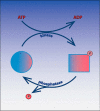Reversible phosphorylation: a birthday tribute to Herb Tabor
- PMID: 30710011
- PMCID: PMC6364790
- DOI: 10.1074/jbc.TME118.004161
Reversible phosphorylation: a birthday tribute to Herb Tabor
Abstract
Herb Tabor was the Editor-in-Chief of the Journal of Biological Chemistry (JBC) spanning the years 1971-2010. This year, Herb turns 100. What do you give a person turning 100? Our answer to this question was to dedicate two of our favorite JBC papers to Herb. Both of these papers focus on reversible phosphorylation, which we briefly review. In addition, we delve into a new finding that centers around a novel family of secreted kinases, suggesting that there are many new and exciting discoveries yet to explore.
Keywords: cancer biology; phosphatase; phosphatase and tensin homolog (PTEN); phospholipid; phosphorylation; protein kinase A (PKA); secretion.
© 2019 Worby and Dixon.
Conflict of interest statement
The authors declare that they have no conflicts of interest with the contents of this article
Figures




Similar articles
-
Cytochrome P450 research and The Journal of Biological Chemistry.J Biol Chem. 2019 Feb 1;294(5):1671-1680. doi: 10.1074/jbc.TM118.004144. Epub 2019 Feb 1. J Biol Chem. 2019. PMID: 29871932 Free PMC article. Review.
-
My 100th JBC paper.J Biol Chem. 2021 Jan-Jun;296:100061. doi: 10.1016/j.jbc.2020.100061. Epub 2020 Nov 18. J Biol Chem. 2021. PMID: 33410410 Free PMC article.
-
Proteases: History, discovery, and roles in health and disease.J Biol Chem. 2019 Feb 1;294(5):1643-1651. doi: 10.1074/jbc.TM118.004156. J Biol Chem. 2019. PMID: 30710012 Free PMC article. Review.
-
Milestones in transcription and chromatin published in the Journal of Biological Chemistry.J Biol Chem. 2019 Feb 1;294(5):1652-1660. doi: 10.1074/jbc.TM118.004162. J Biol Chem. 2019. PMID: 30710013 Free PMC article. Review.
-
A tribute to Prof. Naranjan S. Dhalla, former Editor-in-Chief of Molecular and Cellular Biochemistry.Mol Cell Biochem. 2024 Sep;479(9):2163-2164. doi: 10.1007/s11010-024-05022-z. Mol Cell Biochem. 2024. PMID: 38833033 No abstract available.
Cited by
-
Substrate Activation of the Low-Molecular Weight Protein Tyrosine Phosphatase from Mycobacterium tuberculosis.Biochemistry. 2020 Mar 24;59(11):1137-1148. doi: 10.1021/acs.biochem.0c00059. Epub 2020 Mar 13. Biochemistry. 2020. PMID: 32142609 Free PMC article.
-
Mechanism of microRNA-152-3p-Mediated Regulation of Autophagy and Sensitivity in Paclitaxel-Resistant Ovarian Cancer Cells.Onco Targets Ther. 2025 Feb 4;18:179-197. doi: 10.2147/OTT.S485100. eCollection 2025. Onco Targets Ther. 2025. PMID: 39926373 Free PMC article.
-
Celebrating the scientific legacy of Herbert Tabor.J Biol Chem. 2019 Feb 1;294(5):1635-1637. doi: 10.1074/jbc.TME119.007427. J Biol Chem. 2019. PMID: 30710010 Free PMC article. Review. No abstract available.
-
A Plasmodium falciparum protein tyrosine phosphatase inhibitor identified from the ChEMBL-NTD database blocks parasite growth.FEBS Open Bio. 2021 Jul;11(7):1921-1929. doi: 10.1002/2211-5463.13171. Epub 2021 May 29. FEBS Open Bio. 2021. PMID: 33934569 Free PMC article.
References
-
- Guan K. L., and Dixon J. E. (1991) Evidence for protein-tyrosine-phosphatase catalysis proceeding via a cysteine-phosphate intermediate. J. Biol. Chem. 266, 17026–17030 - PubMed
-
- Lipmann F. (1933) Uber die bindung der phosphorsare in phosphorproteinen. Biochem. Z 262, 9–13
-
- Lipmann F. A., and Levene P. A. (1932) Serine phosphoric acid obtained on hydrolysis of vitellinic acid. J. Biol. Chem. 98, 109–114
Publication types
MeSH terms
Substances
Grants and funding
LinkOut - more resources
Full Text Sources
Research Materials

